Popular categories
Looking for a yarn?

50% Wool, 50% Cotton
from 4.45 $ /50g
Order DROPS Cotton Merino from Wool Warehouse Direct Ltd

|
DROPS Cotton Merino uni colour 50% Wool, 50% Cotton |
4.45 $ /50g |
Order |
Clicking the ORDER button will redirect you to Wool Warehouse Direct Ltd website
The yarn cost is calculated from the pattern’s smallest size and the yarn’s cheapest product type. Looking for an even better price? You might find it on the DROPS Deals!
Northern Wind
Knitted DROPS jacket with raglan, cables, lace pattern and wave pattern in ”Cotton Merino”. Size: S - XXXL.
DROPS design: Pattern no cm-039
Yarn group B
----------------------------------------------------------
Size: S - M - L - XL - XXL - XXXL
Materials:
DROPS COTTON MERINO from Garnstudio
500-550-600-650-750-800 g color no 20, light gray
DROPS DOUBLE POINTED NEEDLES AND CIRCULAR NEEDLE (80 cm / 32'') SIZE 4 mm/US 6 - or size needed to get 21 sts x 28 rows in stockinette st = 4'' x 4'' (10 x 10 cm), and 28 sts x 30 rows in wavepattern = 4'' x 4'' (10 x 10 cm).
DROPS DOUBLE POINTED NEEDLES size 3.5 mm / US 4 – for rib
DROPS BUTTON ARCHED (white), NO 521: 7-7-7-7-8-8 pieces
-------------------------------------------------------
Alternative Yarn – See how to change yarns here
Yarn Groups A to F – Use the same pattern and change the yarn here
Yarn usage using an alternative yarn – Use our yarn converter here
-------------------------------------------------------
Women Jackets & Cardigansbottom up cable lace raglan round neck waist shaping wave pattern

50% Wool, 50% Cotton
from 4.45 $ /50g
Order DROPS Cotton Merino from Wool Warehouse Direct Ltd

|
DROPS Cotton Merino uni colour 50% Wool, 50% Cotton 4.45 $ /50g Order |
Clicking the ORDER button will redirect you to Wool Warehouse Direct Ltd website
The yarn cost is calculated from the pattern’s smallest size and the yarn’s cheapest product type. Looking for an even better price? You might find it on the DROPS Deals!
- English (US/in)
- Česky - not translated
- Dansk
- Deutsch
- Eesti keel
- English (UK/cm)
- Español
- Français
- Íslenska
- Italiano
- Magyar
- Nederlands
- Norsk
- Polski
- Português
- Suomi
- Svenska
- English (UK/cm), Bulgaria
- English (UK/cm), Croatia
- English (UK/cm), Greece
- English (UK/cm), Latvia
- English (UK/cm), Lithuania
- English (UK/cm), Romania
- English (UK/cm), Slovenia
- Česky, Slovakia - not translated
Pattern instructions
K all rows. 1 ridge = K2 rows.
DECREASE TIP:
Dec 1 st by P 2 tog. Dec alternately at beg and end of P section.
PATTERN:
See diagrams A.1 to A.5. The diagrams show all rows in pattern seen from RS. Diagram A.2, A.3 and A.4: See diagram for size!
RAGLAN:
Dec 2 sts in every transition between body and sleeves, dec on each side of A.5. NOTE: Dec differently on body and sleeves.
Dec as follows from RS:
Before A.5: K 2 tog.
After A.5. Slip 1 st as if to K, K 1, psso.
Dec as follows from WS:
Before A.5: P 2 twisted tog.
After A.5. P 2 tog.
BUTTONHOLES:
Dec for buttonholes on right band. 1 buttonhole = K tog 2nd and 3rd st from mid front, then make 1 YO. Dec for buttonholes when piece measures:
SIZE S: 13, 20, 27, 34, 41, 48 and 55 cm /
5",8",10½",13½"16",19",21½"
SIZE M: 13, 20, 27, 34, 41, 49 and 57 cm /
5",8",10½",13½"16",19 1/4",22½''
SIZE L: 13, 20, 27, 35, 43, 51 and 59 cm /
5",8",10½",13 3/4",17",20",23 1/4"
SIZE XL: 13, 21, 29, 37, 45, 53 and 61 cm /
5",8 1/4",11½",14½",17 3/4",21",24"
SIZE XXL: 13, 20, 27, 34, 41, 48, 55 and 63 cm /
5",8",10½",13½"16",19",21½",24 3/4".
SIZE XXXL: 13, 20, 27, 34, 41, 49, 57 and 65 cm /
5",8",10½",13½"16",19 1/4",22½'',25½".
----------------------------------------------------------
BODY:
Worked back and forth on circular needle from mid front.
Cast on 265-282-299-333-367-401 sts (includes 5 band sts in each side towards mid front) on circular needle size 4 mm / US 6 with Cotton Merino. Work next row as follows from WS: Work 5 sts in GARTER ST - see explanation above, work A.1 (= 17 sts) over the next 255-272-289-323-357-391 sts, finish with 5 sts in garter st. Work A.1 one time vertically, on last row in A.1 dec 21-22-23-25-31-41 sts evenly = 244-260-276-308-336-360 sts. Dec for BUTTONHOLES on right band - see explanation above. Then work as follows from RS:
SIZE S-M-L: 5 sts in garter st, K 2, P 2, K 2, P 5, K 2, P 4, K 2, P 5, K 2, P 4, K 2, P 2, K 47-55-63, P 2, K 2, P 5, K 2, P 4, K 2, P 5, K 2, P 4, K 2, P 5, K 2, P 5, K 2, P 4, K 2, P 5, K 2, P 4, K 2, P 5, K 2, P 2, K 47-55-63, P 2, K 2, P 4, K 2, P 5, K 2, P 4, K 2, P 5, K 2, P 2, K 2, 5 sts in garter st.
SIZE XL-XXL-XXXL: 5 sts in garter st, K 2, P 2, K 2, P 5, K 2, P 4, K 2, P 5, K 2, P 4, K 2, P 5, K 2, P 2, K 65-79-91, P 2, K 2, P 5, K 2, P 5, K 2, P 4, K 2, P 5, K 2, P 4, K 2, P 5, K 2, P 5, K 2, P 4, K 2, P 5, K 2, P 4, K 2, P 5, K 2, P 5, K 2, P 2, K 65-79-91, P 2, K 2, P 5, K 2, P 4, K 2, P 5, K 2, P 4, K 2, P 5, K 2, P 2, K 2, 5 sts in garter st.
Continue this pattern, when piece measures 12 cm / 4¾'', dec 1 st in every P section with 4 and 5 sts P - READ DECREASE TIP. Repeat dec when piece measures 17 and 22 cm / 6 3/4" and 8 3/4" = 190-206-222-242-270-294 sts. Continue like this until piece measures 23 cm / 9''. REMEMBER THE KNITTING GAUGE Now work as follows from RS (NOTE: See diagram for size!) 5 sts in garter st, K 2, A.2 a (20-20-20-24-24-24 sts), K 47-55-63-65-79-91, A.3 a (= 42-42-42-50-50-50 sts), K 47-55-63-65-79-91, A.4 a (= 20-20-20-24-24-24 sts), K 2, 5 sts in garter st. Insert 2 markers in the piece; 51-55-59-64-71-77 sts in from each side (back piece = 88-96-104-114-128-140 sts). When A.2 a, A.3 a and A.4 a have been worked one time vertically, continue with A.2 b, A.3 b and A.4 b (there are now 195-211-227-251-279-303 sts on needle). When piece measures 29 cm / 11½'', inc 1 st on each side of every marker (= 4 sts inc). Repeat inc every 3-3-4-4-4-5 cm / 1"-1"-1½''-1½''-2'' 3 more times = 211-227-243-267-295-319 sts. When piece measures 41-42-43-44-45-46 cm / 16 1/8''-16½''-17''-17¼''-17¾''-18'', bind off 4 sts on each side of every marker (= 8 sts in each side) and put piece aside. There are now 91-99-107-119-133-145 sts on back piece and 52-56-60-66-73-79 sts on each front piece.
SLEEVE:
Worked in the round on double pointed needles.
Cast on 52-52-56-56-60-60 sts on double pointed needles size 3.5 mm / US 4 with Cotton Merino. K 1 round. Then work rib (= K 2/P 2). When rib measures 4 cm / 1½'', dec 8-6-8-6-8-6 sts evenly = 44-46-48-50-52-54 sts. Insert 1 marker at beg of round (= mid under sleeve). Switch to double pointed needles size 4 mm / US 6 and work in stockinette st. When piece measures 8 cm / 3 1/8'', inc 2 sts mid under sleeve. Inc every 3-3-2½-2½-2-2 cm / 1 1/8"-1 1/8"-7/8"-7/8"-3/4"-3/4" 13-14-15-16-17-18 times in total = 70-74-78-82-86-90 sts. When piece measures 50-49-49-48-48-47 cm / 19 3/4"-19 1/4"-19 1/4"-19"-19"-18½", bind off the middle 8 sts under sleeve = 62-66-70-74-78-82 sts. Put piece aside and make another sleeve.
YOKE:
Slip sleeves on to same circular needle as body where armholes were bound off = 319-343-367-399-435-467 sts. Then work as follows from RS:
5 sts in garter st, K 2, A.2 (= 21-21-21-26-26-26 sts), K 20-24-28-29-36-42, A.5 (= 7 sts), K 55-59-63-67-71-75, A.5, K 20-24-28-29-36-42, A.3 (= 45-45-45-55-55-55 sts), K 20-24-28-29-36-42, A.5, K 55-59-63-67-71-75, A.5, K 20-24-28-29-36-42, A.4 (= 21-21-21-26-26-26 sts), K 2, 5 sts in garter st. Continue with stockinette st and pattern, on next row from RS beg dec for RAGLAN – see explanation above.
Dec is different on sleeves and front/back piece.
FRONT/BACK PIECE:
Dec every 4th row 4-0-0-0-0-0 times, every other row 16-24-23-25-21-18 times and then every row 0-0-5-4-15-24 times (= 20-24-28-29-36-42 times in total).
SLEEVES:
Dec every other row 22-23-23-24-25-26 times and then every row 2-3-5-6-7-8 times (= 24-26-28-30-32-34 times in total).
After all dec for raglan 143-143-143-163-163-163 sts remain on needle. Work 2 ridges over all sts, on first row dec 43-37-31-45-39-33 sts evenly = 100-106-112-118-124-130 sts. Bind off.
ASSEMBLY: Sew the opening mid under the sleeves. Sew the buttons on to the left band.
This pattern has been corrected. Click here to see the correction/s.
Diagram A.4 size XL-XXL-XXXL: The big cable was turning the wrong way (row 5, 11, 17 and 23).
Diagram
All measurements in charts are in cm.

|
= K from RS, P from WS |

|
= P from RS, K from WS |

|
= 1 YO between 2 sts |

|
= K 2 tog |

|
= slip 1 st as if to K, K 1, psso |

|
= slip 3 sts on cable needle behind piece, K 3, K 3 from cable needle |

|
= slip 3 sts on cable needle in front of piece, K 3, K 3 from cable needle |

|
= no stitch, skip this square |

|
= slip 1 st as if to K, work 2 sts in next st, psso |

|
= slip 1 st as if to K, K 2, psso |
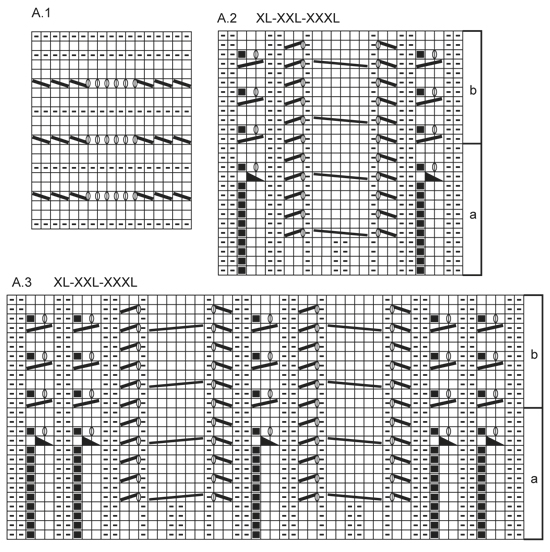
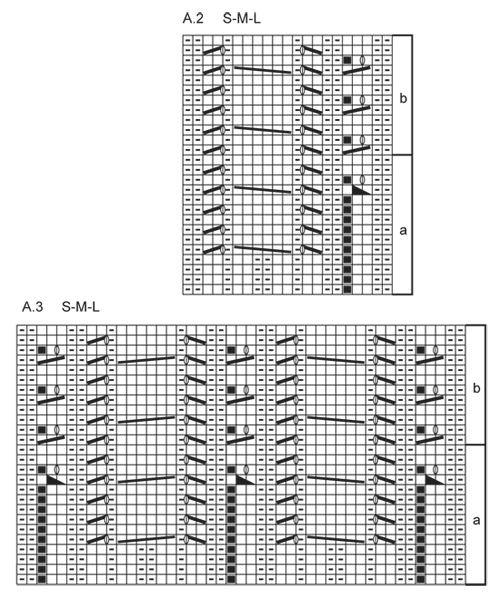
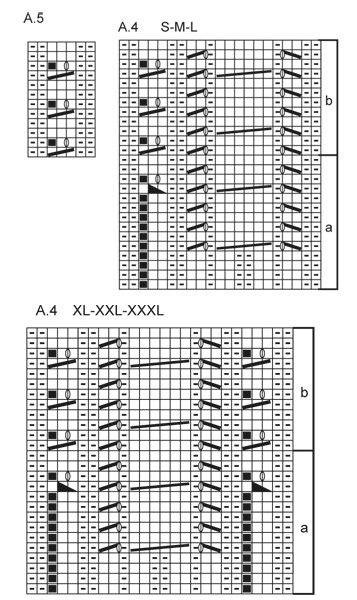

What can you do with our patterns? You can share DROPS patterns online, using the pattern original picture, materials, name and number. But you are NOT ALLOWED to reproduce the complete pattern digitally in any way. Yarn stores are welcome to use the DROPS pattern database to promote the sale of our assortment. You can print out our patterns, make as many copies as you’d like. The only thing we ask is that you don't make any changes / additions to the original printed document. And that the patterns according to the DROPS philosophy are given out to the consumers for free. Editorials that wish to publish our patterns in printed books or magazines can contact us for more information. The sale of garments based on DROPS patterns is permitted as long as they are sold as single items or per order. Further commercial use of the patterns is not permitted. It has to be clearly stated that the garment is made based on a design from DROPS DESIGN. The use of clothing labels of which DROPS DESIGN forms part is conditioned by the inclusion of the following text: “A DROPS DESIGN made by …..”. The use of DROPS photos for marketing purposes/sales is only permitted in connection with the use/sale of DROPS products. The photos may not be cut or edited and the logo should be clearly visible.
We reserve the right to withdraw the permission for use of our patterns at any time, notwithstanding the reason.
Each of our patterns has specific tutorial videos to help you.
These step-by-step tutorials might also help you:
Why is the knitting/crochet tension so important?
Knitting tension is what determines the final measurements of your work, and is usually measured per 10 x 10 cm. It is provided like so: number of stitches in width x number of rows in height - eg: 19 stitches x 26 rows = 10 x 10 cm.
The knitting tension is very individual; some people knit/crochet loosely while others work tightly. You adjust the knitting tension with the needle size, which is why the suggested needle size only serve as a guide! You need to adjust this (up or down) to ensure that YOUR knitting tension matches the knitting tension provided in the pattern. If you work with a different knitting tension than provided you will have a different yarn consumption, and your work will have different measurements than what the pattern suggests.
The knitting tension also determines which yarns can replace each other. As long as you achieve the same knitting tension you can replace one yarn with another.
See DROPS lesson: How to measure your tension/gauge
See DROPS video: How to make a gauge tension swatch
How do I know how many balls of yarn I need?
The required amount of yarn is provided in grams, eg: 450 g. To calculate how many balls you’ll need you first need to know how many grams are in 1 ball (25g, 50g or 100g). This information is available if you click on the individual yarn quality on our pages. Divide the amount required with the amount of each ball. For example, if each ball is 50g (the most common amount), the calculation will be as follows: 450 / 50 = 9 balls.
Can I use a different yarn than what the pattern suggests?
The important thing when changing from one yarn to another is that the knitting/crochet tension remains the same. This is so that the measurements of the finished piece will be the same as on the sketch provided. It is easier to achieve the same knitting tension using yarns from the same yarn group. It is also possible to work with multiple strands of a thinner yarn to achieve the knitting tension of a thicker one. Please try our yarn converter. We recommend you to always work a test swatch.
Please NOTE: when changing yarn the garment might have a different look and feel to the garment in the photo, due to individual properties and qualities of each yarn.
See DROPS lesson: Can I use a different yarn than the one mentioned in the pattern?
What are the yarn groups?
All our yarns are categorised into yarn groups (from A to F) according to thickness and knitting tension – group A contains the thinnest yarns and group F the thickest. This makes it easier for you to find alternative yarns to our patterns, should you wish to switch yarn. All yarns within the same group have a similar knitting tension and can easily replace each other. However, different yarn qualities have different structures and properties which will give the finished work a unique look and feel.
How do I use the yarn converter?
At the top of all our patterns you’ll find a link to our yarn converter, which is a helpful tool should you wish to use a different yarn than suggested. By filling in the yarn quality you wish to replace, the amount (in your size) and number of strands, the converter will present good alternative yarns with the same knitting tension. Additionally it will tell you how much you’ll require in the new qualities and whether you’ll need to work with multiple strands. Most skeins are 50g (some are 25g or 100g).
If the pattern is worked with multiple colours, every colour will have to be converted separately. Similarly, if the pattern is worked with several strands of different yarns (for example 1 strand Alpaca and 1 strand Kid-Silk) you will have to find alternatives for each, individually.
Why do you show discontinued yarns in the patterns?
Since different yarns have different qualities and textures we have chosen to keep the original yarn in our patterns. However, you can easily find options among our available qualities by using our yarn converter, or simply pick a yarn from the same yarn group.
It is possible that some retailers still have discontinued yarns in stock, or that someone has a few skeins at home that they would like to find patterns for.
The yarn converter will provide both alternative yarn as well as required amount in the new quality.
What size should I knit?
If you think it's hard to decide what size to make, it can be a good idea to measure a garment you own already and like the size of. Then you can pick the size by comparing those measures with the ones available in the pattern's size chart.
You'll find the size chart at the bottom of the pattern.
See DROPS lesson: How to read size chart
Why do I get the wrong knitting tension with the suggested needle size?
The needle size provided in the pattern serves only as a guide, the important thing is to follow the knitting tension. And since knitting tension is very individual, you will have to adjust the needle size to ensure that YOUR tension is the same as in the pattern – maybe you’ll have to adjust 1, or even 2 needle sizes, up or down to achieve the correct tension. For this, we recommend that you work test swatches.
Should you work with a different knitting tension than the one provided, the measurements of the finished garment might deviate from the measurement sketch.
See DROPS lesson: How to measure your tension/gauge
See DROPS video: How to make a gauge tension swatch
Why is the pattern worked top-down?
Working a garment top-down provides more flexibility and room for personal adjustment. For example it is easier to try the garment on while working, as well as making adjustments to length of yoke and shoulder caps.
The instructions are carefully explaining every step, in the correct order. Diagrams are adjusted to the knitting direction and are worked as usual.
How do I work according to a knitting diagram?
The diagram depicts all rows/rounds, and every stitch seen from the right side. It is read from bottom to top, from right to left. 1 square = 1 stitch.
When working back and forth, every other row is worked from the right side and every other row is worked from the wrong side. When working from the wrong side, the diagram will have to be worked reversed: from left to right, knit stitches are purled, purl stitches are knit etc.
When working in the round every round is worked from the right side and the diagram are worked from right to left on all rounds.
See DROPS lesson: How to read knitting diagrams
How do I work according to a crochet diagram?
The diagram depicts all rows/rounds, and every stitch seen from the right side. It is worked from bottom to top, from right to left.
When working back and forth every other row is worked from the right side: from right to left and every other row is worked from the wrong side: from left to right.
When working in the round, every row in the diagram are worked from the right side, from right to left.
When working a circular diagram you start in the middle and work your way outwards, counter clockwise, row by row.
The rows usually start with a given number of chain stitches (equivalent to the height of the following stitch), this will either be depicted in the diagram or explained in the pattern.
See DROPS lesson: How to read crochet diagrams
How do I work several diagrams simultaneously on the same row/round?
Instructions for working several diagrams after each other on the same row/round, will often be written like so: “work A.1, A.2, A.3 a total of 0-0-2-3-4 times". This means you work A.1 once, then A.2 is worked once, and A.3 is repeated (in width) the number of times provided for your size – in this case like so: S = 0 times, M = 0 times, L=2 times, XL= 3 times and XXL = 4 times.
The diagrams are worked as usual: begin with the first row in A.1, then work the first row in A.2 etc.
See DROPS lesson: How to read knitting diagrams
See DROPS lesson: How to read crochet diagrams
Why are the sleeves shorter in larger sizes?
The total width of the garment (from wrist-to-wrist) will be larger in the larger sizes, despite the actual sleeves being shorter. The larger sizes have longer sleeve caps and wider shoulders, so there will be a good fit in all sizes.
Where on the garment is the length measured?
The measurement sketch/schematic drawing provides information regarding the full length of the garment. If it’s a jumper or a jacket the length is measured from the highest point on the shoulder (usually closest to the neckline), and straight down to the bottom of the garment. It is NOT measured from the tip of shoulder. Similarly, the length of yoke is measured from the highest point on the shoulder and down to where yoke is split into body and sleeves.
See DROPS lesson: How to read a schematic drawing
What is a repeat?
Diagrams are often repeated on the round or in height. 1 repeat is the diagram the way it appears in the pattern. If it says to work 5 repeats of A.1 in the round, then you work A.1 a total of 5 times after/next to each other in the round. If it says to work 2 repeats of A.1 vertically/in height you work the entire diagram once, then begin again at the start and work the entire diagram one more time.
Why does the piece start with more chain stitches than it’s worked with?
Chain stitches are slightly narrower than other stitches and to avoid working the cast-on edge too tight, we simply chain more stitches to begin with. The stitch count will be adjusted on the following row to fit the pattern and measurement sketch.
Why increase before the rib edge when the piece is worked top-down?
The rib edge is more elastic and will contract slightly compared to, for example, stocking stitch. By increasing before the rib edge, you avoid a visible difference in width between the rib edge and the rest of the body.
Why increase in the cast-off edge?
It’s very easy to cast off too tightly, and by making yarn overs while casting off (and simultaneously casting these off) you avoid a too tight cast off edge.
See DROPS video: How to bind off with yarn overs (yo)
How do I increase/decrease on every 3rd and 4th row/round alternately?
To achieve an even increase (or decrease) you can increase on, for example: every 3rd and 4th row alternately, like so: work 2 rows and increase on the 3rd row, work 3 rows and increase on the 4th. Repeat this until the increase is complete.
See DROPS lesson: Increase or decrease 1 st on every 3rd and 4th row alternately
How can I work a jacket in the round instead of back and forth?
Should you prefer to work in the round instead of back and forth, you may of course adjust the pattern. You’ll need to add steeks mid-front (usually 5 stitches), and follow the instructions. When you would normally turn and work from the wrong side, simply work across the steek and continue in the round. At the end you’ll cut the piece open, pick up stitches to work bands, and cover the cut edges.
See DROPS video: How to knit steeks and cut open
Can I work a jumper back and forth instead of in the round?
Should you prefer to work back and forth instead of in the round, you may of course adjust the pattern so you work the pieces separately and then assemble them at the end. Divide the stitches for the body in 2, add 1 edge stitch in each side (for sewing) and work the front and back pieces separately.
See DROPS lesson: Can I adapt a pattern for circular needles into straight needles?
Why is the pattern slightly different than what I see in the photo?
Pattern repeats can vary slightly in the different sizes, in order to get the correct proportions. If you’re not working the exact same size as the garment in the photo, yours might deviate slightly. This has been carefully developed and adjusted so that the complete impression of the garment is the same in all sizes.
Make sure to follow instructions and diagrams for your size!
How do I make a women’s size garment into a men’s size one?
If you have found a pattern you like which is available in women’s size it’s not very difficult to convert it to men’s size. The biggest difference will be the length of sleeves and body. Start working on the women size that you think would fit across the chest. The additional length will be worked right before you cast off for the armhole/sleeve cap. If the pattern is worked top-down you can add the length right after the armhole or before the first decrease on sleeve.
Regarding additional yarn amount, this will depend on how much length you add, but it is better with a skein too many than too few.
How do I prevent a hairy garment from shedding?
All yarns will have excess fibres (from production) that might come off as lint or shedding. Brushed yarns (ie hairier yarns) have more of these loose, excess fibres, causing more shedding.
Shedding also depends on what is worn under or over the garment, and whether this pulls at the yarn fibres. It’s therefore not possible to guarantee that there will be no shedding
Below are some tips on how to get the best result when working with hairier yarns:
1. When the garment is finished (before you wash it) shake it vigorously so the looser hairs come off. NOTE: do NOT use a lint roller, brush or any method that pulls at the yarn.
2. Place the garment in a plastic bag and put it in your freezer - the temperature will cause the fibres to become less attached to each other, and excess fibres will come off easier.
3. Leave in the freezer for a few hours before taking it out and shaking it again.
4. Wash the garment according to the instructions on the yarn label.
Why does my garment pill?
Pilling is a natural process that happens to even the most exclusive of fibers. It's a natural sign of wear and tear that is hard to avoid, and that is most visible in high friction areas of your garment like a sweater's arms and cuffs.
You can make your garment look as new by removing the pilling, using a fabric comb or a pill/lint remover.
In the meantime, you can read the questions and answers that others have left to this pattern or join the DROPS Workshop on Facebook to get help from fellow knitters/crocheters!
You might also like...
Northern Wind |
|||||||||||||||||||||||||||||||
 |
 |
||||||||||||||||||||||||||||||
Knitted DROPS jacket with raglan, cables, lace pattern and wave pattern in ”Cotton Merino”. Size: S - XXXL.
DROPS 165-16 |
|||||||||||||||||||||||||||||||
|
GARTER ST (back and forth): K all rows. 1 ridge = K2 rows. DECREASE TIP: Dec 1 st by P 2 tog. Dec alternately at beg and end of P section. PATTERN: See diagrams A.1 to A.5. The diagrams show all rows in pattern seen from RS. Diagram A.2, A.3 and A.4: See diagram for size! RAGLAN: Dec 2 sts in every transition between body and sleeves, dec on each side of A.5. NOTE: Dec differently on body and sleeves. Dec as follows from RS: Before A.5: K 2 tog. After A.5. Slip 1 st as if to K, K 1, psso. Dec as follows from WS: Before A.5: P 2 twisted tog. After A.5. P 2 tog. BUTTONHOLES: Dec for buttonholes on right band. 1 buttonhole = K tog 2nd and 3rd st from mid front, then make 1 YO. Dec for buttonholes when piece measures: SIZE S: 13, 20, 27, 34, 41, 48 and 55 cm / 5",8",10½",13½"16",19",21½" SIZE M: 13, 20, 27, 34, 41, 49 and 57 cm / 5",8",10½",13½"16",19 1/4",22½'' SIZE L: 13, 20, 27, 35, 43, 51 and 59 cm / 5",8",10½",13 3/4",17",20",23 1/4" SIZE XL: 13, 21, 29, 37, 45, 53 and 61 cm / 5",8 1/4",11½",14½",17 3/4",21",24" SIZE XXL: 13, 20, 27, 34, 41, 48, 55 and 63 cm / 5",8",10½",13½"16",19",21½",24 3/4". SIZE XXXL: 13, 20, 27, 34, 41, 49, 57 and 65 cm / 5",8",10½",13½"16",19 1/4",22½'',25½". ---------------------------------------------------------- BODY: Worked back and forth on circular needle from mid front. Cast on 265-282-299-333-367-401 sts (includes 5 band sts in each side towards mid front) on circular needle size 4 mm / US 6 with Cotton Merino. Work next row as follows from WS: Work 5 sts in GARTER ST - see explanation above, work A.1 (= 17 sts) over the next 255-272-289-323-357-391 sts, finish with 5 sts in garter st. Work A.1 one time vertically, on last row in A.1 dec 21-22-23-25-31-41 sts evenly = 244-260-276-308-336-360 sts. Dec for BUTTONHOLES on right band - see explanation above. Then work as follows from RS: SIZE S-M-L: 5 sts in garter st, K 2, P 2, K 2, P 5, K 2, P 4, K 2, P 5, K 2, P 4, K 2, P 2, K 47-55-63, P 2, K 2, P 5, K 2, P 4, K 2, P 5, K 2, P 4, K 2, P 5, K 2, P 5, K 2, P 4, K 2, P 5, K 2, P 4, K 2, P 5, K 2, P 2, K 47-55-63, P 2, K 2, P 4, K 2, P 5, K 2, P 4, K 2, P 5, K 2, P 2, K 2, 5 sts in garter st. SIZE XL-XXL-XXXL: 5 sts in garter st, K 2, P 2, K 2, P 5, K 2, P 4, K 2, P 5, K 2, P 4, K 2, P 5, K 2, P 2, K 65-79-91, P 2, K 2, P 5, K 2, P 5, K 2, P 4, K 2, P 5, K 2, P 4, K 2, P 5, K 2, P 5, K 2, P 4, K 2, P 5, K 2, P 4, K 2, P 5, K 2, P 5, K 2, P 2, K 65-79-91, P 2, K 2, P 5, K 2, P 4, K 2, P 5, K 2, P 4, K 2, P 5, K 2, P 2, K 2, 5 sts in garter st. Continue this pattern, when piece measures 12 cm / 4¾'', dec 1 st in every P section with 4 and 5 sts P - READ DECREASE TIP. Repeat dec when piece measures 17 and 22 cm / 6 3/4" and 8 3/4" = 190-206-222-242-270-294 sts. Continue like this until piece measures 23 cm / 9''. REMEMBER THE KNITTING GAUGE Now work as follows from RS (NOTE: See diagram for size!) 5 sts in garter st, K 2, A.2 a (20-20-20-24-24-24 sts), K 47-55-63-65-79-91, A.3 a (= 42-42-42-50-50-50 sts), K 47-55-63-65-79-91, A.4 a (= 20-20-20-24-24-24 sts), K 2, 5 sts in garter st. Insert 2 markers in the piece; 51-55-59-64-71-77 sts in from each side (back piece = 88-96-104-114-128-140 sts). When A.2 a, A.3 a and A.4 a have been worked one time vertically, continue with A.2 b, A.3 b and A.4 b (there are now 195-211-227-251-279-303 sts on needle). When piece measures 29 cm / 11½'', inc 1 st on each side of every marker (= 4 sts inc). Repeat inc every 3-3-4-4-4-5 cm / 1"-1"-1½''-1½''-2'' 3 more times = 211-227-243-267-295-319 sts. When piece measures 41-42-43-44-45-46 cm / 16 1/8''-16½''-17''-17¼''-17¾''-18'', bind off 4 sts on each side of every marker (= 8 sts in each side) and put piece aside. There are now 91-99-107-119-133-145 sts on back piece and 52-56-60-66-73-79 sts on each front piece. SLEEVE: Worked in the round on double pointed needles. Cast on 52-52-56-56-60-60 sts on double pointed needles size 3.5 mm / US 4 with Cotton Merino. K 1 round. Then work rib (= K 2/P 2). When rib measures 4 cm / 1½'', dec 8-6-8-6-8-6 sts evenly = 44-46-48-50-52-54 sts. Insert 1 marker at beg of round (= mid under sleeve). Switch to double pointed needles size 4 mm / US 6 and work in stockinette st. When piece measures 8 cm / 3 1/8'', inc 2 sts mid under sleeve. Inc every 3-3-2½-2½-2-2 cm / 1 1/8"-1 1/8"-7/8"-7/8"-3/4"-3/4" 13-14-15-16-17-18 times in total = 70-74-78-82-86-90 sts. When piece measures 50-49-49-48-48-47 cm / 19 3/4"-19 1/4"-19 1/4"-19"-19"-18½", bind off the middle 8 sts under sleeve = 62-66-70-74-78-82 sts. Put piece aside and make another sleeve. YOKE: Slip sleeves on to same circular needle as body where armholes were bound off = 319-343-367-399-435-467 sts. Then work as follows from RS: 5 sts in garter st, K 2, A.2 (= 21-21-21-26-26-26 sts), K 20-24-28-29-36-42, A.5 (= 7 sts), K 55-59-63-67-71-75, A.5, K 20-24-28-29-36-42, A.3 (= 45-45-45-55-55-55 sts), K 20-24-28-29-36-42, A.5, K 55-59-63-67-71-75, A.5, K 20-24-28-29-36-42, A.4 (= 21-21-21-26-26-26 sts), K 2, 5 sts in garter st. Continue with stockinette st and pattern, on next row from RS beg dec for RAGLAN – see explanation above. Dec is different on sleeves and front/back piece. FRONT/BACK PIECE: Dec every 4th row 4-0-0-0-0-0 times, every other row 16-24-23-25-21-18 times and then every row 0-0-5-4-15-24 times (= 20-24-28-29-36-42 times in total). SLEEVES: Dec every other row 22-23-23-24-25-26 times and then every row 2-3-5-6-7-8 times (= 24-26-28-30-32-34 times in total). After all dec for raglan 143-143-143-163-163-163 sts remain on needle. Work 2 ridges over all sts, on first row dec 43-37-31-45-39-33 sts evenly = 100-106-112-118-124-130 sts. Bind off. ASSEMBLY: Sew the opening mid under the sleeves. Sew the buttons on to the left band. |
|||||||||||||||||||||||||||||||
Diagram explanations |
|||||||||||||||||||||||||||||||
|
|||||||||||||||||||||||||||||||

|
|||||||||||||||||||||||||||||||

|
|||||||||||||||||||||||||||||||

|
|||||||||||||||||||||||||||||||

|
|||||||||||||||||||||||||||||||
|
Have you made this or any other of our designs? Tag your pictures in social media with #dropsdesign so we can see them! Do you need help with this pattern?You'll find tutorial videos, a Comments/Questions area and more by visiting the pattern on garnstudio.com. © 1982-2024 DROPS Design A/S. We reserve all rights. This document, including all its sub-sections, has copyrights. Read more about what you can do with our patterns at the bottom of each pattern on our site. |
|||||||||||||||||||||||||||||||
With over 40 years in knitting and crochet design, DROPS Design offers one of the most extensive collections of free patterns on the internet - translated to 17 languages. As of today we count 304 catalogs and 11422 patterns - 11417 of which are translated into English (US/in).
We work hard to bring you the best knitting and crochet have to offer, inspiration and advice as well as great quality yarns at incredible prices! Would you like to use our patterns for other than personal use? You can read what you are allowed to do in the Copyright text at the bottom of all our patterns. Happy crafting!







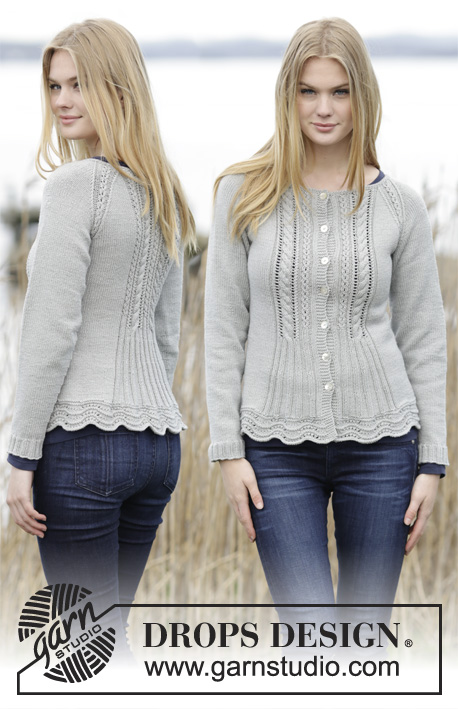
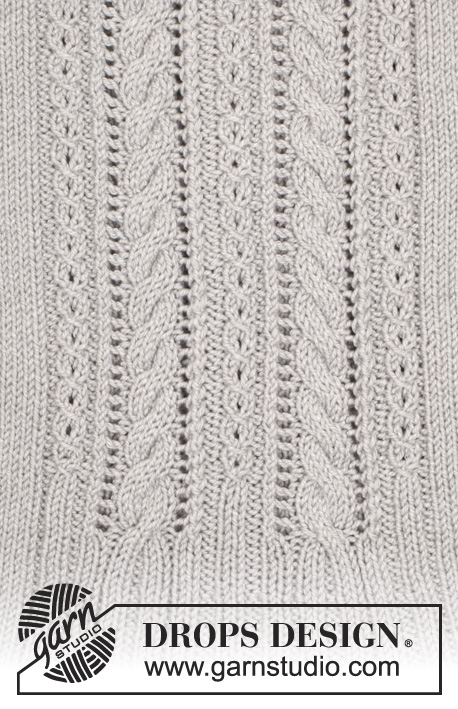


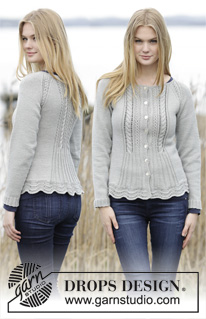



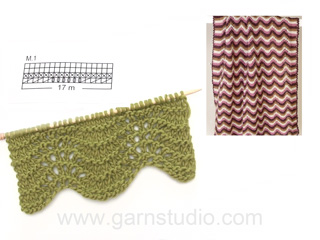








































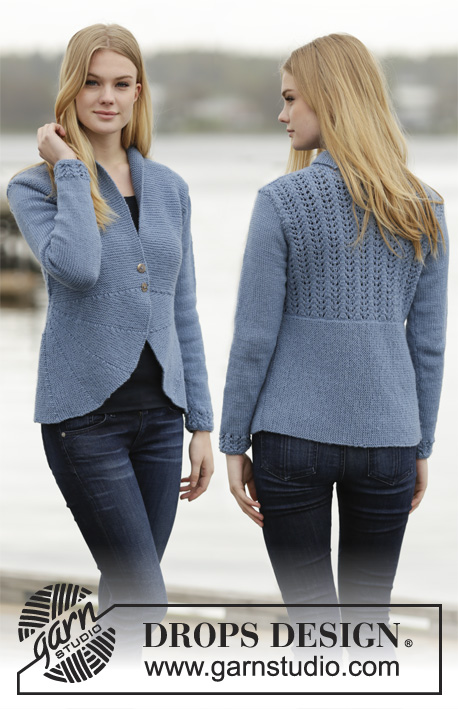
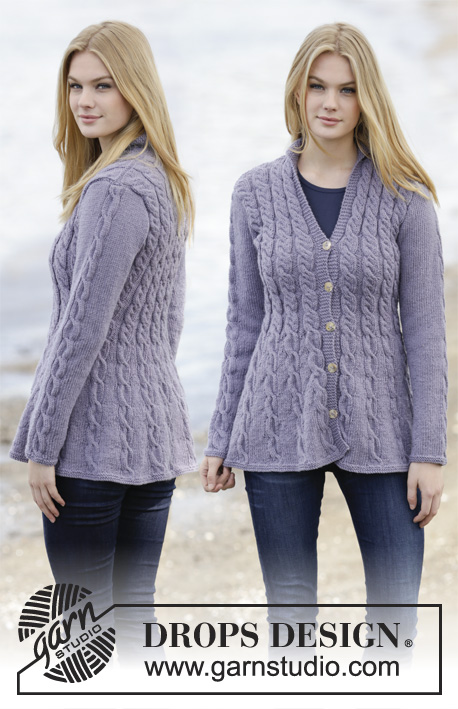






Comments / Questions (74)
Due to an eye problem I am unable to read charts. I understand them but don't see the symbols in the proper place, but I can read written instructions Ok ,sometimes I have to magnify but it doesn;t seem to work the same with charts..my question is, Can I make this cardi without a chart please
13.11.2023 - 01:45Bonjour sur le dernier rang de a1 je dois diminuer 25 m sur les333 que j'ai . Je n'arrive pas à calculer tous les combien de mailles je dois tricoter 2 ensemble. Merci pour votre aide
25.08.2022 - 10:34DROPS Design answered:
Bonjour Mme Bernard, Retirez la bordure des devants (10 mailles) de ces 333 mailles = 323 et divisez par le nombre de diminutions = 12.9 - cette leçon va vous aider à calculer comment répartir vos diminutions - cf Exemple 2. Bon tricot!
25.08.2022 - 11:47Hej jag undrar hur mönster A 1 ska stickas får det inte att stämma
30.07.2021 - 10:36DROPS Design answered:
Hej Gudrun, varv 4 stickar du såhär: 2ihop, 2ihop, 2ihop, omslag, 1r, omslag, 1r, omslag, 1r,omslag, 1r, omslag, 1 r, 1omslag, 2ihop, 2ihop, 2ihop. Nu har du lika många omslag som maskor du stickar ihop. Börja om med 2 ihop x 3 osv...
05.08.2021 - 13:30Hej, jeg forstår ikke indtagning til raglan, der står forstyk og rygstyk for sig og ærmer for sig, men de hænger da sammen, (forstyk og ærme) og ( rygstyk og ærme) På forhånd tak, Mvh Joan.
22.07.2021 - 21:24DROPS Design answered:
Hej Joan, ja du har alle masker på en rundpind og så tager du ind i hver raglanovergang, på hver side af A.5. Læs i stykket øverst hvor der står RAGLAN: God fornøjelse!
05.08.2021 - 13:53I am working on the sleeves and am worried they might end up too long. I don't understand why size small has longer sleeves than size large. If my arm measures 47 cm from armpit to wrist would it be correct to knit the sleeve until it is 47 cm long then join it with the body?
26.04.2021 - 13:38DROPS Design answered:
Dear Julie, it might be wise to measure a similar jacket you have and like the shape and compare the measurement with these in the chart - Read more here about chart - remember numbers in chart are in cm. Happy knitting!
26.04.2021 - 14:40Is dit patroon ook beschikbaar om te breien met breinaalden met knop? Ik vind breien met rondbreinaalden moeilijk.
22.02.2021 - 09:33DROPS Design answered:
Dag Monique,
We hebben hiervoor geen apart patroon en vanwege de patronen die doorlopen in de zijnaden en de raglan is dit model niet zo geschikt om met rechte naalden te breien. Tenzij je heel erg handig bent in het aanpassen, zodat deze stukken mooi door kunnen lopen.
Om een patroon aan te passen om op rechte naalden te breien hebben we een instructie gemaakt. Deze vind je hier.
23.02.2021 - 12:50I am trying to get the right size for my wife. I was never good with metric math. I think I have the right size but I am not sure about the amount of yarn I will need to complete the sweater. I am pretty sure that the size large (my wife isn't big ) but she doesn't like here sweaters fitting too snuggly. How many skeins would I need for the size large so I can place my order ASAP. Thank you!!!!
03.02.2021 - 04:24DROPS Design answered:
Hi Roy, Cotton Merino comes in 50 g skeins and you need 600 g for size large. This will be 12 skeins. Happy knitting!
03.02.2021 - 07:53I am confused on the A2b thru A4b pattern. The first row of the pattern (where it starts with b) you have a slip 1 st as if to K, K 2, psso. The next line above it shows that there should be 2 stitches. However, this stitch decreases 3 stitches to 1. Your video shows the stitch as 3 stitches into 1.
23.11.2020 - 06:12DROPS Design answered:
Dear Carol, you slip 1 stitch as if to K, knit the next 2 stitches (do not knit them together) and pass the slipped stitch over the knitted stitches = you decreased 1 stitch = 2 sts remain between the purl sts. Happy knitting!
23.11.2020 - 10:30Ha quedado precioso, tal cual el modelo!!!!
09.11.2020 - 21:152. Teil Ich befürchte, hier liegt ein Fehler vor, vor allem, weil bei anderen Massskizzen von DROPS die Hüftweite gleichmässig ansteigt. Damit wäre auch die Anschlagsmaschenzahl falsch...
24.05.2020 - 20:27